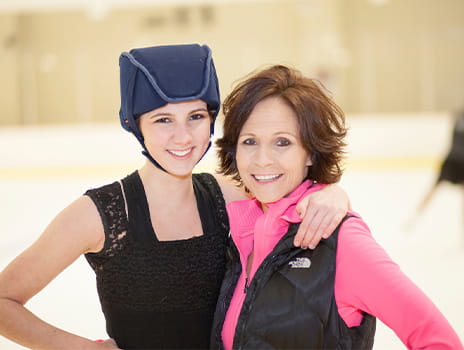All the Right Moves

In recognition of the upcoming Martin Luther King Jr. Day holiday, some of The University of Kansas Health System’s offices will have modified hours on Monday, January 19.
The University of Kansas Health System is experiencing a high volume of patients seeking care for influenza and other respiratory illnesses. Whether you plan to visit the health system or not, learn how to keep yourself healthy.

November 01, 2018
Hospital helps Madeline Mudd survive a stroke and return to skating
Last summer, Marcy Mudd received a text from her then 16-year-old daughter, Madeline. The competitive synchronized ice skater let her mom know she would practice for another hour before heading home.
Not 5 minutes later, Marcy got a call from the skating rink manager. Madeline had collapsed on the ice.
To watch Madeline Mudd today, you would never know she experienced a major stroke caused by a ruptured aneurysm. Yet when she arrived at The University of Kansas Health System's main campus, her condition was critical. Her brain was bleeding, and she had no bodily reflexes. Her chances of survival were slim.
"No one expected her to live through the night," said Marcy. "And no one dreamed she’d figure skate again."
Madeline was life-flighted to The University of Kansas Hospital, one of the first in the nation – and the only in the region – to become an Advanced Comprehensive Stroke Center. She was rushed into surgery, where the acute stroke response team led by neurosurgeon Roukoz Chamoun, MD, was ready to save her life and prevent further damage to her brain.
Dr. Chamoun clipped the aneurysm to prevent further bleeding, but Madeline’s brain continued to swell, threatening her brain stem and her life. She returned to surgery for a decompressive craniectomy.
During this procedure, the front lobes of Madeline’s skull were removed to give the young brain room to expand without being squeezed. Dr. Chamoun then sewed the pieces of skull into Madeline’s abdomen to keep the bone viable and alive until it could be moved back into place months later.
Madeline’s brain pressure was under control, but her fight was not over. In the hospital’s state-of-the-art neurosciences ICU, neurointensivists discovered with the aid of a transcranial Doppler ultrasound that Madeline was experiencing vasospasms, a narrowing of blood vessels that restricts blood flow and increases the risk of stroke.
Madeline’s heart, weakened from the hemorrhage, couldn’t keep up with the demands of the high blood pressure necessary to maintain blood flow to the brain. Guided through the femoral artery to the heart, a balloon pump was inserted to help increase blood flow to the brain without adding stress to the heart. Successfully used in about 2 dozen adult patients worldwide, the balloon pump had not previously been used at the hospital for a pediatric vasospasm case. Madeline was the first.
We offer a variety of appointment types. Learn more or call 913-588-1227 to schedule now.
The day before Madeline was released to rehabilitation, just 3 weeks after she collapsed on the ice, she walked around the entire ICU.
Her recovery showed that, with aggressive medical and surgical management, patients with these hemorrhages – despite the complications they have – can hope for a good outcome.
Madeline returned to school and returned to the rink and skating competition. She even invited her care team to watch her show and skate with her afterward.
"Every nurse I encountered, every doctor, they’re just top-notch and so incredibly intelligent," said Marcy. "They save lives. They saved Madeline’s life. That’s what they do. I’m a believer in The University of Kansas Health System."
We visited with Madeline recently for an update on her progress. Learn what she’s doing now.